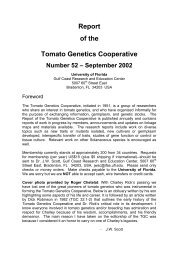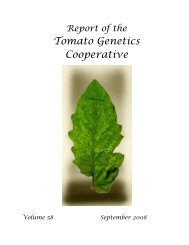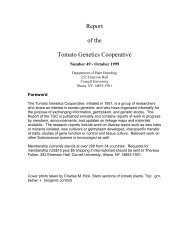Volume 60 - Tomato Genetics Cooperative - University of Florida
Volume 60 - Tomato Genetics Cooperative - University of Florida
Volume 60 - Tomato Genetics Cooperative - University of Florida
Create successful ePaper yourself
Turn your PDF publications into a flip-book with our unique Google optimized e-Paper software.
acteria (vascular or not) and even fungi (vascular) within single tomato genotypes.<br />
Hence, Scott (1997) advised that when searching for resistance to a given bacterial<br />
pathogen, breeders should not overlook genotypes resistant to other bacteria. In this<br />
regard, resistance genes can emerge by combining genotypes with some reported<br />
bacterial resistance even when one <strong>of</strong> the parent lines does not show resistance to a<br />
particular disease/race. For instance, Hutton et al. (2010) reported that an allele from<br />
„Hawaii 7998‟ was associated with resistance to bacterial spot race T4 even though this<br />
line was susceptible to race T4, suggesting epistasis with genes from the other parent<br />
that was T4 resistant. Another possibility is that the pleiotropic nature <strong>of</strong> resistance in<br />
tomato against several diseases could be associated with higher level <strong>of</strong> expression <strong>of</strong><br />
systemic acquired resistance (SAR). Lin et al (2004) found over-expression <strong>of</strong><br />
Arabidopsis NPR1 (non-expresser <strong>of</strong> PR genes) gene in a susceptible tomato line could<br />
enhance resistance to both Fusarium wilt race 2, bacterial wilt, as well as bacterial spot<br />
and gray leaf spot. In this study, they did not test the enhanced resistance against the<br />
bacterial canker pathogen.<br />
Lastly, Rouamba et al. (1988) tested material resistant to bacterial wilt towards a<br />
fourth vascular disease, the Verticillium wilt caused by Verticillium race 2, but they found<br />
only a loose relationship between both resistances since only two („IRAT L3‟ and<br />
„Farako-Ba‟) out <strong>of</strong> ten lines tested, were resistant to both diseases.<br />
5. Grafting <strong>of</strong> susceptible cultivars on resistant rootstocks, an alternative to<br />
resistant cultivars<br />
Given the difficulty to create highly resistant lines with good commercial quality,<br />
grafting susceptible scions on resistant rootstocks remains an alternative to the<br />
cultivation <strong>of</strong> resistant cultivars. As early as 1969, Gilbert and Chin pointed out that<br />
highly resistant tomato lines with poor fruit quality, could be efficiently used as<br />
rootstocks on which susceptible scions <strong>of</strong> good fruit quality could be grafted. These<br />
authors reported the bacterial wilt resistance <strong>of</strong> the root system as being effective even<br />
when completely susceptible scions are used. This technique is still used nowadays<br />
(Cardoso et al., 2006; Wang et al., 2009), though the protection provided by the<br />
rootstock is sometimes incomplete (Nakaho et al., 2004). Indeed, tomato resistant<br />
material harbours the bacteria symptomlessly and the resistance is associated with the<br />
ability <strong>of</strong> the plant to restrict bacteria invasiveness (Grimault et al., 1993). The absence<br />
<strong>of</strong> incompatible interactions in tomato resistant lines (no symptoms, no latent infection)<br />
has been confirmed by Lebeau et al. (2011) by testing a core collection <strong>of</strong> bacterial wilt<br />
resistant accessions with a core collection <strong>of</strong> bacterial strains.<br />
Eggplant is an alternative rootstock for cultivating susceptible tomatoes in<br />
contaminated conditions. It was shown to provide a better protection than tomato<br />
rootstocks (AVRDC, 1998). This result was confirmed and extended by Lebeau et al.<br />
(2011) who found that apart from common cases <strong>of</strong> latent infection for some eggplant<br />
accessions and all tomato accessions, there also exist incompatible interactions<br />
between some eggplant resistant lines and some bacterial strains. Further, some<br />
eggplant lines control bacterial strains that are not controlled by any <strong>of</strong> the tomato<br />
resistant lines tested so far, as exemplified by Carmeille et al. (2006b), Wicker et al.<br />
(2007) and Lebeau et al. (2011).<br />
17





